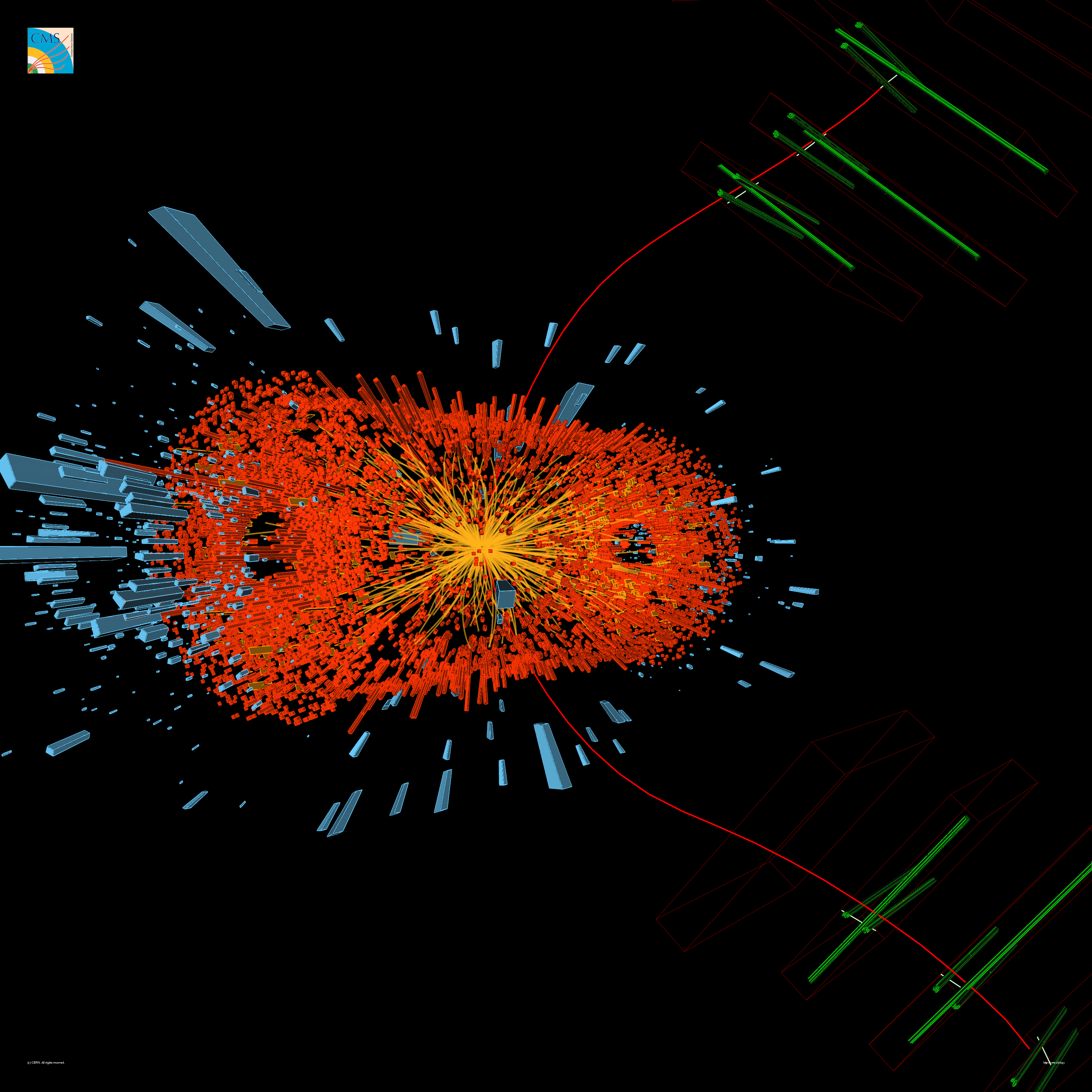
The Quark Matter 2012 conference, held in Washington DC from 13-18 August 2012, brings together experimental and theoretical experts in the area of heavy-ion physics. This week, the CMS collaboration is presenting many exciting new results using high-luminosity data corresponding to approximately 1 billion lead-ion collisions delivered by the LHC in 2011. CMS has continued the exploration of the properties of the hot and dense matter produced in the collisions using rare processes available for the first time this year.
The production rates of several quarkonium states (Y(1S,2S,3S), J/Ψ, Ψ(2S)) have been measured in PbPb and pp collisions (Figure 1). These bound states of heavy quark-antiquark pairs (charm or beauty) are of particular interest, since in the presence of deconfined quarks and gluons, or a quark-gluon plasma state, the force that binds the pair together is reduced. This would result in suppression of quarkonium production in PbPb collisions, in comparison to the production in pp collisions. Due to their different binding energies, the various quarkonium states are expected to “melt” in the plasma at different temperatures. Although suppression in production of quarkonium states has been previously observed in heavy-ion collisions, the new CMS results show for the first time a suppression pattern of five different particles, ordered according to their binding energy. The suppression factors, RAA, scaled to be unity if nuclear collisions are a simple superposition of pp collisions, are plotted in Figure 2 as a function of the binding energy of the respective quarkonium state. The new CMS measurements provide a “thermometer” for the produced medium and hints of deconfinement.
To be able to characterize the properties of this medium, CMS has conducted a comprehensive set of measurements aiming to understand how the medium interacts with particles of different nature. It is imperative that the particles that would be used as “probes” are not part of the thermalized medium itself. It has long been recognized that jets (groups of particles carrying high transverse-momentum, pT, emitted within a narrow cone) can serve as tomographic probes of the medium. The majority of the produced jets originate in the violent scatterings of gluons or light quarks (up, down, or strange). In rare instances, the outgoing parton is a heavy (charm or beauty) quark, or the jet partner may be an electroweak boson (photon, or Z). Particles that interact via the strong interaction (quarks and gluons) are expected to lose a significant fraction of their energy, while propagating through the quark-gluon plasma, and thus the corresponding jets will be “quenched”. The amount of lost energy may depend on the flavour of the parton. On the other hand, particles that only participate in electroweak interactions would not experience such energy loss. The total energy lost in the medium depends on the amount of material traversed by the partons. Since nuclei are extended objects, they may collide head-on or barely touch each other, and thus produce a medium of varying volume. The collisions are classified by their centrality, defined as a percentage of the total nuclear inelastic cross-section, where 0% indicates a head-on collision, and 100% - a grazing collision. The most central collisions are the ones where the largest jet-modifications in the hot fireball are expected.
Utilizing the high-luminosity data set from 2011, the CMS collaboration has investigated the jet-quenching phenomenon in great detail using a variety of rare probes and fully reconstructed jets. The quenching of the heavy b-quarks is studied via their decays into J/Ψ mesons and, for the first time, with fully reconstructed b-jets. Figure 3 presents a collection of results for the nuclear modification factors (RAA) of various single particles (left panel) and fully reconstructed jets (right panel). Electroweak bosons (γ, W, Z) remain unmodified by the medium and their production serves as a reference process. A remarkably similar suppression is observed for all other probes, including the heavy b-jets, indicating that the medium is extremely opaque.
To quantify the amount of jet energy-loss in the medium precisely, photon-jet events have been studied for the first time in collisions of varying centrality. The jet structure is also examined using correlations of di-jets, jets and charged particles, or pairs of charged particles. The jet fragmentation functions and jet shapes are studied including charged hadrons down to low transverse momentum (pT = 1 GeV/c). The jet modifications due to energy loss are assessed by comparing the jet structure in PbPb collisions to that in pp collisions (Figure 4). A centrality dependent modification is observed at large distance from the jet axis (top panels), and in the fragmentation into particles with low momenta (appearing at large values of ξ in the bottom panels). The jets get broader and contain more low momentum particles, when the volume of the medium is larger.
Owing to the wide acceptance of the CMS detector and its unique triggering capabilities, the studies of the bulk properties of the medium are extended to unprecedented kinematic range. Measurements of higher-order Fourier-components of the azimuthal particle distributions in ultra-central PbPb collisions are shown to be a sensitive indicator of the viscosity to entropy ratio of the medium. Initial comparisons to theoretical calculations confirm that this ratio remains close to the quantum lower bound of a “perfect liquid”, as previously observed at RHIC.
The new CMS results based on 2011 data provide a more complete picture of the medium produced in high-energy heavy ion collisions. Sequential quarkonium melting has been observed for the first time, hinting that the medium may comprise deconfined quarks and gluons. The medium is found to be extremely opaque to jets, and “flowing” collectively. In the near future, CMS will continue this exploration, by performing similar measurements in proton-lead collisions. Under these conditions, “cold” nuclear matter with very different properties is expected to be formed, thus they serve as a valuable control experiment.
More details on all these results may be found in the CMS presentations at QM 2012.
By Julia Velkovska and Gabor Veres
- Log in to post comments

